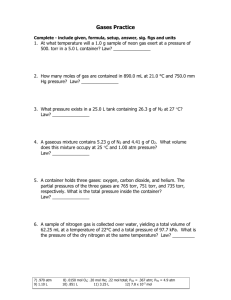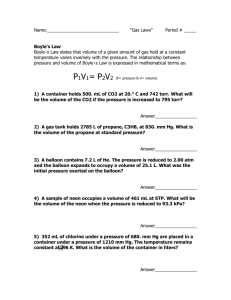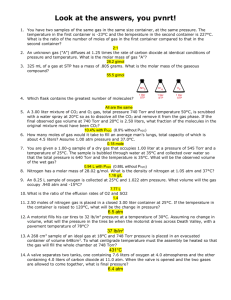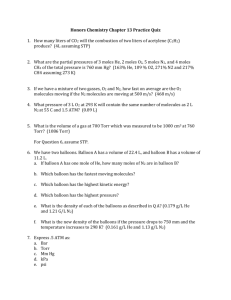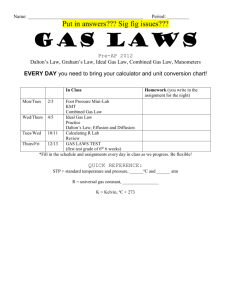Gas Laws Review Part 1: Boyles, Charles, Gay
advertisement
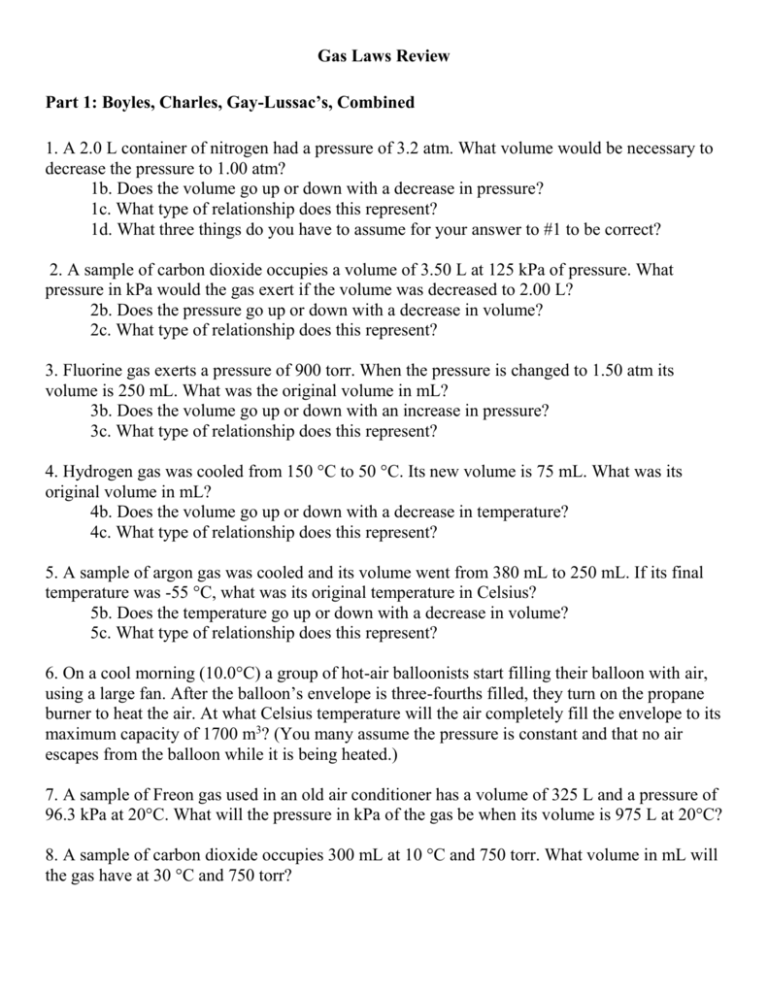
Gas Laws Review Part 1: Boyles, Charles, Gay-Lussac’s, Combined 1. A 2.0 L container of nitrogen had a pressure of 3.2 atm. What volume would be necessary to decrease the pressure to 1.00 atm? 1b. Does the volume go up or down with a decrease in pressure? 1c. What type of relationship does this represent? 1d. What three things do you have to assume for your answer to #1 to be correct? 2. A sample of carbon dioxide occupies a volume of 3.50 L at 125 kPa of pressure. What pressure in kPa would the gas exert if the volume was decreased to 2.00 L? 2b. Does the pressure go up or down with a decrease in volume? 2c. What type of relationship does this represent? 3. Fluorine gas exerts a pressure of 900 torr. When the pressure is changed to 1.50 atm its volume is 250 mL. What was the original volume in mL? 3b. Does the volume go up or down with an increase in pressure? 3c. What type of relationship does this represent? 4. Hydrogen gas was cooled from 150 °C to 50 °C. Its new volume is 75 mL. What was its original volume in mL? 4b. Does the volume go up or down with a decrease in temperature? 4c. What type of relationship does this represent? 5. A sample of argon gas was cooled and its volume went from 380 mL to 250 mL. If its final temperature was -55 °C, what was its original temperature in Celsius? 5b. Does the temperature go up or down with a decrease in volume? 5c. What type of relationship does this represent? 6. On a cool morning (10.0°C) a group of hot-air balloonists start filling their balloon with air, using a large fan. After the balloon’s envelope is three-fourths filled, they turn on the propane burner to heat the air. At what Celsius temperature will the air completely fill the envelope to its maximum capacity of 1700 m3? (You many assume the pressure is constant and that no air escapes from the balloon while it is being heated.) 7. A sample of Freon gas used in an old air conditioner has a volume of 325 L and a pressure of 96.3 kPa at 20°C. What will the pressure in kPa of the gas be when its volume is 975 L at 20°C? 8. A sample of carbon dioxide occupies 300 mL at 10 °C and 750 torr. What volume in mL will the gas have at 30 °C and 750 torr? 9. A 2.50 L volume of hydrogen measured at the normal boiling point of nitrogen is warmed to the normal boiling point of water and expands to become 12.1 L. Calculate the normal boiling point of nitrogen in Celsius. 10. A sample of helium gas has a volume of 100.0 mL. Its pressure is 0.960 atm at 25 °C. What is its pressure at a temperature of 35°C? 11. 5.6 g of oxygen gas has a pressure of 765 torr at 22 °C. What is the new temperature in Celsius of the gas if the pressure is changed to 780 torr? 12. Have you ever noticed that an aerosol spray can gets cold when you spray the gas out of the can? Guy-Lussac’s Law supports the idea that as the pressure decreases, so does the temperature. A sample of gas at a pressure of 1.05 atm (high pressure) and a temperature of 22 °C (room temperature) is released out of a can. The new pressure is standard pressure. What is the new temperature of the gas in Celsius? 13. A hydrogen-filled balloon has a volume of 3.20 L at 752 torr and 30°C. When allowed to an altitude where the pressure of the gas is 715 torr, the balloon has the volume of 3.32 L. What is the temperature at that altitude in Celsius? 14. A given mass of air at a given temperature has a volume of 6.0 L at 1.0 atm. What pressure in mmHg will it have if the volume is 24.0 L? 15. If a given sample of gas occupies 8.60 L at 327°C, what will be its temperature (°C) if it has a volume of 8.00 L if the pressure does not change? 16. Calculate the temperature in Kelvin to which 200 mL of a gas at 273 K and 750 torr must be heated to increase the volume to 250 mL at 740 torr. Part 2: Ideal 1. What is the pressure, in atmospheres, exerted by a 0.500 mol sample of nitrogen in a 10.0 L container at 25.0°C? 2. What is the volume occupied by 0.250 mol of oxygen at 20.0°C and 740.0 mmHg pressure? 3. What pressure, in atmospheres, is exerted by 0.6565 g of hydrogen gas in a 4.08 L container at 35.0°C? 4. A sample of hydrogen gas has a volume of 8560 mL at standard temperature and a pressure of 1.50 atm. Calculate the number of moles of H2 present in this gas sample. 5. What mass of chlorine gas, in grams, is contained in a 100.0 mL tank at 27.0°C and 2660 mmHg of pressure? 7. At what temperature will a 10.00 g sample of neon gas exert a pressure of 96.7 kPa in a 9.50 L container? 8. What is the mass, in grams, of oxygen gas in a 12.5 L container at 45.0°C and 7.22 atm? 9. What is the volume of 1.00 mole of carbon dioxide at standard temperature and pressure? Part 3: Graham’s 1. Which gas moves faster across the room, NH3 or He? Why? 2. What is the relative rate of diffusion of NH3 compared to He? 3. Under the same conditions of temperature and pressure, how many times faster will hydrogen effuse compared to carbon dioxide? 5. The rate of diffusion of an unknown gas is 4.0 times faster than the rate of oxygen gas. What is the molar mass and name of the unknown gas? 6. Ammonia, NH3, and alcohol, C2H6O, are released together across a room. Which will you smell first? Why? 7. Mathematically, give the relative rates of diffusion of oxygen to hydrogen. Now turn this mathematical answer into a verbal statement regarding their rates of diffusion. Part 4: Dalton 1. What is the total pressure in atmospheres of a gaseous mixture containing 1.00 g of He, 2.00 g of H2, and 3.00 g N2 in a 10.0 L container at 300 K? 2. A 54.0 mL sample of oxygen is collected over water at 23°C and 770.0 torr pressure. What is the volume of the dry gas at STP? (Vapor pressure of water at 23°C = 21.1 torr) 3. A tank contains 480.0 grams of oxygen and 80.00 grams of helium at a total pressure of 7.00 atmospheres. Calculate the following. a) How many moles of O2 are in the tank? b) How many moles of He are in the tank? c) Total moles of gas in tank. d) Mole fraction of O2. e) Mole fraction of He. f) Partial pressure of O2. g) Partial pressure of He. 4. A mixture of 14.0 grams of hydrogen, 84.0 grams of nitrogen, and 2.0 moles of oxygen are placed in a flask. When the partial pressure of the oxygen is 78.00 mm of mercury, what is the total pressure in the flask?





